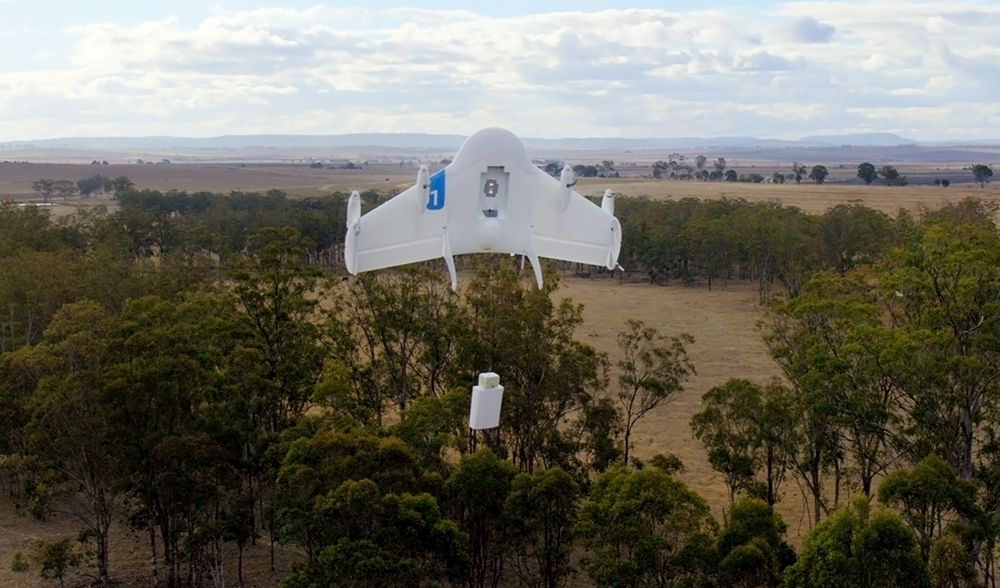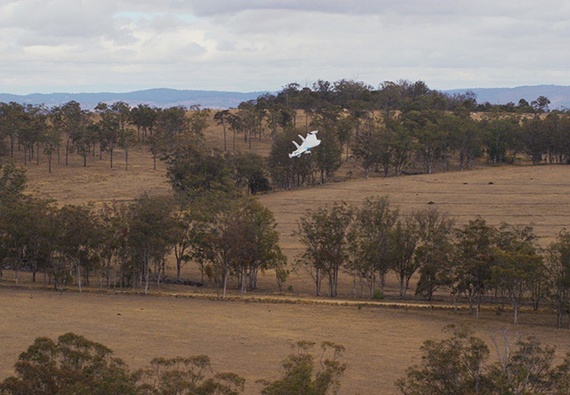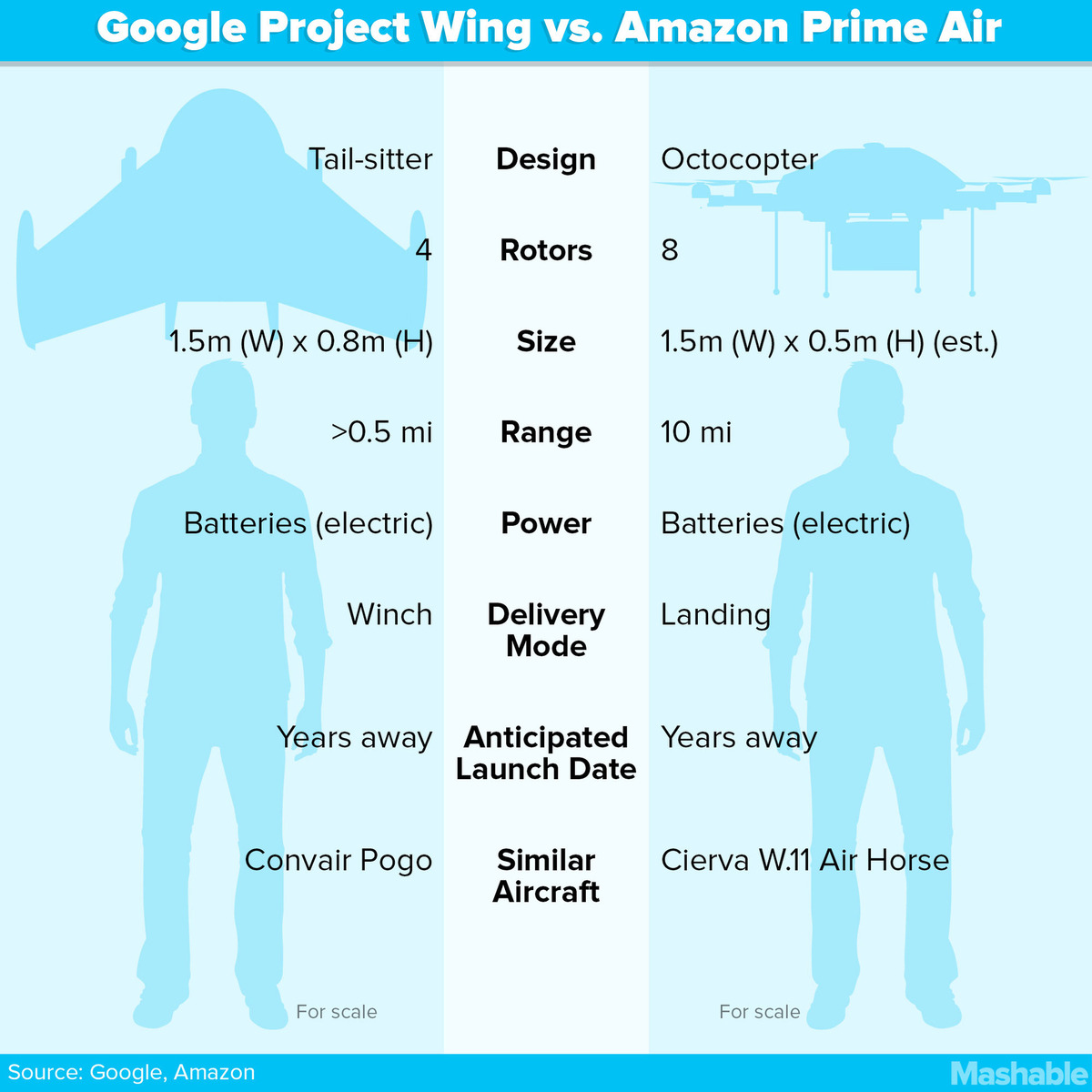Google's Project Wing Is So Far The Most Practical Delivery Drone Program Out There
Amazon is building drones to deliver things consumers buy, and Facebook is building drones so more people can get Internet access. And naturally, Google has been tinkering with drones, too.
On 28 August, Internet giant Google confirmed that it has been running secret drone delivery tests with their own Unmanned Aerial Vehicles (UAV) prototypes. Google's skunkworks Google X has been working on Project Wing for a couple of years.
This undated image provided by Google shows a Project Wing drone vehicle during delivery.
Image via washingtonpost.comMove over, Amazon. Google has just entered the commercial drone arms race with Project Wing, an until-now secret program to develop "self-flying vehicles" to deliver small packages, similar to Amazon's Prime Air.
Both programs are still years away from coming to fruition, with prototype drones — or, more accurately, unmanned aerial vehicles (UAVs) — completing only the most basic of test flights. However, the drones have been in development for a while, with notably different approaches to drone design. Google has been working on drones for two years; Amazon announced its program in December of last year.
Although Project Wing can be used to deliver purchased goods online, similar to Amazon, Google, according to BBC, is imaging a more humanitarian application: disaster relief
Google said that its long-term goal was to develop drones that could be used for disaster relief by delivering aid to isolated areas. They could be used after earthquakes, floods, or extreme weather events, the company suggested, to take small items such as medicines or batteries to people in areas that conventional vehicles cannot reach.
"Even just a few of these, being able to shuttle nearly continuously could service a very large number of people in an emergency situation," Google X's Astro Teller told the BBC in an interview. He also admitted to The Atlantic that dozens of people are currently working on the project, with the hope of delivering goods to people in a quick and efficient manner.
For Project Wing, Google X, in-charge of "moonshot" projects at Google, eventually settled on a tail-sitting aircraft design, which combines elements of a helicopter and a fixed-wing airplane
Rotors are mounted toward the front of the plane, which lift the plane from the ground since it sits with its tail pointed downward. Once it's in the air, it can reorient itself to fly like a plane, which lets it fly faster than a typical copter design.
Boasting a wingspan of about five feet, each Google drone features four electrical propellers and weighs about 19 pounds. It appears the weight of the drone and the item it is delivering can only weigh 22 pounds, meaning it will be limited to delivering small goods. Other features include a computer near the tail, power at the front, and hardware like GPS, cameras, radios, and an inertial measurement sensor comprised of accelerometers and gyroscopes.
Google says the model shown in its test video is one of many iterations and shouldn't be taken as the final design
Nevertheless, Google may have settled on the ideal design for drone delivery: a craft that can take off and land slowly and safely, has the ability to hover so it can take its time when unloading its cargo, and can also fly like a plane so it can travel large distances quickly and efficiently.
"With vertical and horizontal flight, speed and efficiency come into the equation," Google spokesperson Raymond Gobberg said. "The fixed wing helps it get there faster, but then when it transitions into hover, we're able to lower the package. But this is only one of vehicles we're testing."
 gizmodo.com
gizmodo.com
The ability to stop and hover is in no way unique to Project Wing, but it is the key feature for delivering packages, and it's why most drones feature a helicopter or ducted-fan design
After all, most customers won't have room for a runway for a drone to land on, and parachuting packages from above isn't really an option (Google tried it and found that wind affected precise targeting too much).
Google apparently agrees, which is why it decided to add a winch to the drone to perform the actual delivery. The tail-sitting design allows the drone to hover over the delivery target, then drop the item, attached to a fishing line, letting gravity pull it down at 10 meters per second (m/s). When it gets close to the ground, it slows things down to 2 m/s.
 gizmodo.com
gizmodo.com
In Amazon's teaser video for Prime Air, a drone first lands in front of a house, drops its payload, then flies off a few seconds later. It's very simple, although some people criticized the depiction, saying that anything with rotating blades will be tempting to kids and curious onlookers, which represents a safety risk.
Once it gets to Earth, it releases the package and retracts the cable, leaving the drone high in the air and away from any potentially meddling hands. Conversely, Amazon's drop-ship approach isn't inherently unsafe, but it does introduce a wild card that Project Wing doesn't.
The testing was conducted in Australia where commercial drone use is far more permissive than in the U.S., although rules are moving in that direction
The Federal Aviation Administration is considering revising the restrictions, and in June approved a drone flight over land in Alaska. Amazon has requested permission to test its drone delivery program in the U.S. Google says its drones would eventually operate along programmed routes at altitudes of 130 to 200 feet.
The FAA has been in talks with Google about its drone program, which is in very preliminary stages and at least several years away from being operational. But even to test drones in the U.S., Google has to get special permission, the FAA spokesperson said. The FAA currently has over 30 special requests, including one from Amazon for its Amazon Prime Air program. Google hasn’t yet filed an application and is testing Project Wing in Australia.
However, actual drone delivery, at least by Google, is still years off. The project's next goal is to determine if delivery by UAV is even viable.
Then it will focus on safety features to handle potential problems like midair collisions and crashes. It also wants to reduce the noise made by its drones and fine tune navigation features to address issues like privacy.
cnn.com



